QEasingCurve¶
- PyQt5.QtCore.QEasingCurve
Description¶
The QEasingCurve class provides easing curves for controlling animation.
Easing curves describe a function that controls how the speed of the interpolation between 0 and 1 should be. Easing curves allow transitions from one value to another to appear more natural than a simple constant speed would allow. The QEasingCurve class is usually used in conjunction with the QVariantAnimation and QPropertyAnimation classes but can be used on its own. It is usually used to accelerate the interpolation from zero velocity (ease in) or decelerate to zero velocity (ease out). Ease in and ease out can also be combined in the same easing curve.
To calculate the speed of the interpolation, the easing curve provides the function valueForProgress(), where the progress argument specifies the progress of the interpolation: 0 is the start value of the interpolation, 1 is the end value of the interpolation. The returned value is the effective progress of the interpolation. If the returned value is the same as the input value for all input values the easing curve is a linear curve. This is the default behaviour.
For example,
# QEasingCurve easing(QEasingCurve::InOutQuad);
# for (qreal t = 0.0; t < 1.0; t += 0.1)
# qWarning() << "Effective progress" << t << "is"
# << easing.valueForProgress(t);
will print the effective progress of the interpolation between 0 and 1.
When using a QPropertyAnimation, the associated easing curve will be used to control the progress of the interpolation between startValue and endValue:
# QPropertyAnimation animation;
# animation.setStartValue(0);
# animation.setEndValue(1000);
# animation.setDuration(1000);
# animation.setEasingCurve(QEasingCurve::InOutQuad);
The ability to set an amplitude, overshoot, or period depends on the QEasingCurve type. Amplitude access is available to curves that behave as springs such as elastic and bounce curves. Changing the amplitude changes the height of the curve. Period access is only available to elastic curves and setting a higher period slows the rate of bounce. Only curves that have “boomerang” behaviors such as the InBack, OutBack, InOutBack, and OutInBack have overshoot settings. These curves will interpolate beyond the end points and return to the end point, acting similar to a boomerang.
The Easing Curves Example contains samples of QEasingCurve types and lets you change the curve settings.
Enums¶
- Type
The type of easing curve.
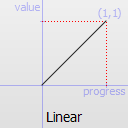
Easing curve for a linear (t) function: velocity is constant.
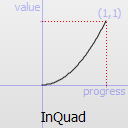
Easing curve for a quadratic (t^2) function: accelerating from zero velocity.
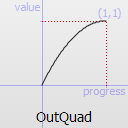
Easing curve for a quadratic (t^2) function: decelerating to zero velocity.
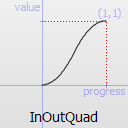
Easing curve for a quadratic (t^2) function: acceleration until halfway, then deceleration.
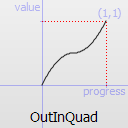
Easing curve for a quadratic (t^2) function: deceleration until halfway, then acceleration.
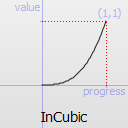
Easing curve for a cubic (t^3) function: accelerating from zero velocity.
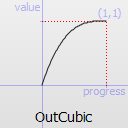
Easing curve for a cubic (t^3) function: decelerating to zero velocity.

Easing curve for a cubic (t^3) function: acceleration until halfway, then deceleration.
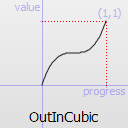
Easing curve for a cubic (t^3) function: deceleration until halfway, then acceleration.

Easing curve for a quartic (t^4) function: accelerating from zero velocity.
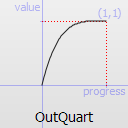
Easing curve for a quartic (t^4) function: decelerating to zero velocity.
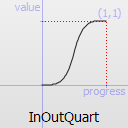
Easing curve for a quartic (t^4) function: acceleration until halfway, then deceleration.
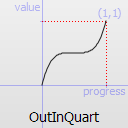
Easing curve for a quartic (t^4) function: deceleration until halfway, then acceleration.
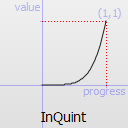
Easing curve for a quintic (t^5) easing in: accelerating from zero velocity.

Easing curve for a quintic (t^5) function: decelerating to zero velocity.
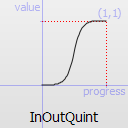
Easing curve for a quintic (t^5) function: acceleration until halfway, then deceleration.
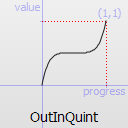
Easing curve for a quintic (t^5) function: deceleration until halfway, then acceleration.
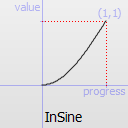
Easing curve for a sinusoidal (sin(t)) function: accelerating from zero velocity.
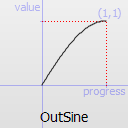
Easing curve for a sinusoidal (sin(t)) function: decelerating to zero velocity.
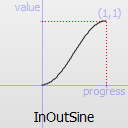
Easing curve for a sinusoidal (sin(t)) function: acceleration until halfway, then deceleration.
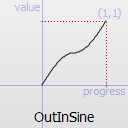
Easing curve for a sinusoidal (sin(t)) function: deceleration until halfway, then acceleration.
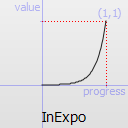
Easing curve for an exponential (2^t) function: accelerating from zero velocity.
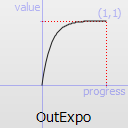
Easing curve for an exponential (2^t) function: decelerating to zero velocity.
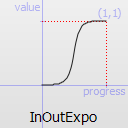
Easing curve for an exponential (2^t) function: acceleration until halfway, then deceleration.

Easing curve for an exponential (2^t) function: deceleration until halfway, then acceleration.
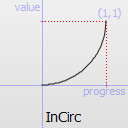
Easing curve for a circular (sqrt(1-t^2)) function: accelerating from zero velocity.
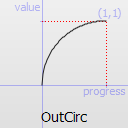
Easing curve for a circular (sqrt(1-t^2)) function: decelerating to zero velocity.
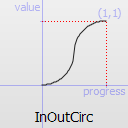
Easing curve for a circular (sqrt(1-t^2)) function: acceleration until halfway, then deceleration.
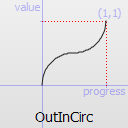
Easing curve for a circular (sqrt(1-t^2)) function: deceleration until halfway, then acceleration.
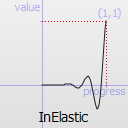
Easing curve for an elastic (exponentially decaying sine wave) function: accelerating from zero velocity. The peak amplitude can be set with the amplitude parameter, and the period of decay by the period parameter.
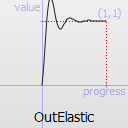
Easing curve for an elastic (exponentially decaying sine wave) function: decelerating to zero velocity. The peak amplitude can be set with the amplitude parameter, and the period of decay by the period parameter.

Easing curve for an elastic (exponentially decaying sine wave) function: acceleration until halfway, then deceleration.
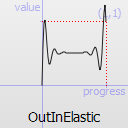
Easing curve for an elastic (exponentially decaying sine wave) function: deceleration until halfway, then acceleration.
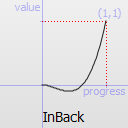
Easing curve for a back (overshooting cubic function: (s+1)*t^3 - s*t^2) easing in: accelerating from zero velocity.
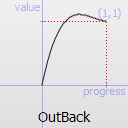
Easing curve for a back (overshooting cubic function: (s+1)*t^3 - s*t^2) easing out: decelerating to zero velocity.

Easing curve for a back (overshooting cubic function: (s+1)*t^3 - s*t^2) easing in/out: acceleration until halfway, then deceleration.
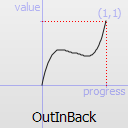
Easing curve for a back (overshooting cubic easing: (s+1)*t^3 - s*t^2) easing out/in: deceleration until halfway, then acceleration.
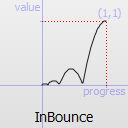
Easing curve for a bounce (exponentially decaying parabolic bounce) function: accelerating from zero velocity.
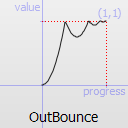
Easing curve for a bounce (exponentially decaying parabolic bounce) function: decelerating from zero velocity.
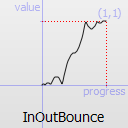
Easing curve for a bounce (exponentially decaying parabolic bounce) function easing in/out: acceleration until halfway, then deceleration.
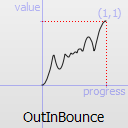
Easing curve for a bounce (exponentially decaying parabolic bounce) function easing out/in: deceleration until halfway, then acceleration.
See also
addCubicBezierSegment()addTCBSegment().
Member
Value
Description
BezierSpline TODO
Allows defining a custom easing curve using a cubic bezier spline
CosineCurve TODO
TODO
Custom 45
This is returned if the user specified a custom curve type with setCustomType(). Note that you cannot call setType() with this value, but type() can return it.
InBack TODO
TODO
InBounce TODO
TODO
InCirc TODO
TODO
InCubic TODO
TODO
InCurve TODO
TODO
InElastic TODO
TODO
InExpo TODO
TODO
InOutBack TODO
TODO
InOutBounce TODO
TODO
InOutCirc TODO
TODO
InOutCubic TODO
TODO
InOutElastic TODO
TODO
InOutExpo TODO
TODO
InOutQuad TODO
TODO
InOutQuart TODO
TODO
InOutQuint TODO
TODO
InOutSine TODO
TODO
InQuad TODO
TODO
InQuart TODO
TODO
InQuint TODO
TODO
InSine TODO
TODO
Linear TODO
TODO
OutBack TODO
TODO
OutBounce TODO
TODO
OutCirc TODO
TODO
OutCubic TODO
TODO
OutCurve TODO
TODO
OutElastic TODO
TODO
OutExpo TODO
TODO
OutInBack TODO
TODO
OutInBounce TODO
TODO
OutInCirc TODO
TODO
OutInCubic TODO
TODO
OutInElastic TODO
TODO
OutInExpo TODO
TODO
OutInQuad TODO
TODO
OutInQuart TODO
TODO
OutInQuint TODO
TODO
OutInSine TODO
TODO
OutQuad TODO
TODO
OutQuart TODO
TODO
OutQuint TODO
TODO
OutSine TODO
TODO
SineCurve TODO
TODO
TCBSpline TODO
Allows defining a custom easing curve using a TCB spline
Methods¶
- __init__(Union[QEasingCurve, Type])
Construct a copy of other.
- amplitude() → float
Returns the amplitude. This is not applicable for all curve types. It is only applicable for bounce and elastic curves (curves of type() InBounce, OutBounce, InOutBounce, OutInBounce, InElastic, OutElastic, InOutElastic or OutInElastic).
See also
- customType() → Callable[[float], float]
Returns the function pointer to the custom easing curve. If type() does not return Custom, this function will return 0.
See also
- __eq__(Union[QEasingCurve, Type]) → bool
TODO
- __ne__(Union[QEasingCurve, Type]) → bool
TODO
- overshoot() → float
Returns the overshoot. This is not applicable for all curve types. It is only applicable if type() is InBack, OutBack, InOutBack or OutInBack.
See also
- period() → float
Returns the period. This is not applicable for all curve types. It is only applicable if type() is InElastic, OutElastic, InOutElastic or OutInElastic.
See also
- setAmplitude(float)
Sets the amplitude to amplitude.
This will set the amplitude of the bounce or the amplitude of the elastic “spring” effect. The higher the number, the higher the amplitude.
See also
- setCustomType(Callable[[float], float])
TODO
- setOvershoot(float)
Sets the overshoot to overshoot.
0 produces no overshoot, and the default value of 1.70158 produces an overshoot of 10 percent.
See also
- setPeriod(float)
Sets the period to period. Setting a small period value will give a high frequency of the curve. A large period will give it a small frequency.
See also
- swap(QEasingCurve)
TODO
- toCubicSpline() → List[QPointF]
TODO
- valueForProgress(float) → float
Return the effective progress for the easing curve at progress. Whereas progress must be between 0 and 1, the returned effective progress can be outside those bounds. For example, InBack will return negative values in the beginning of the function.
